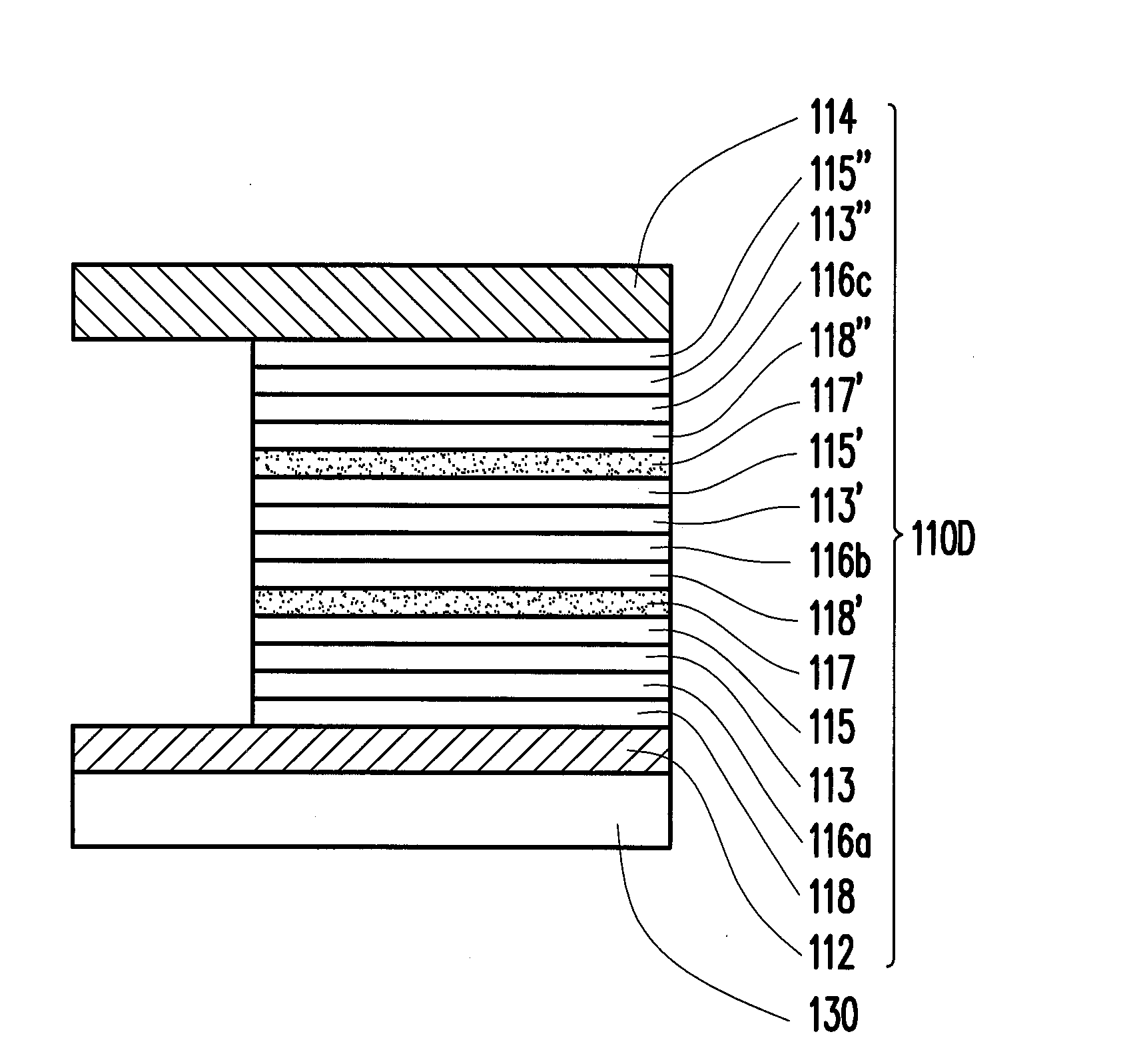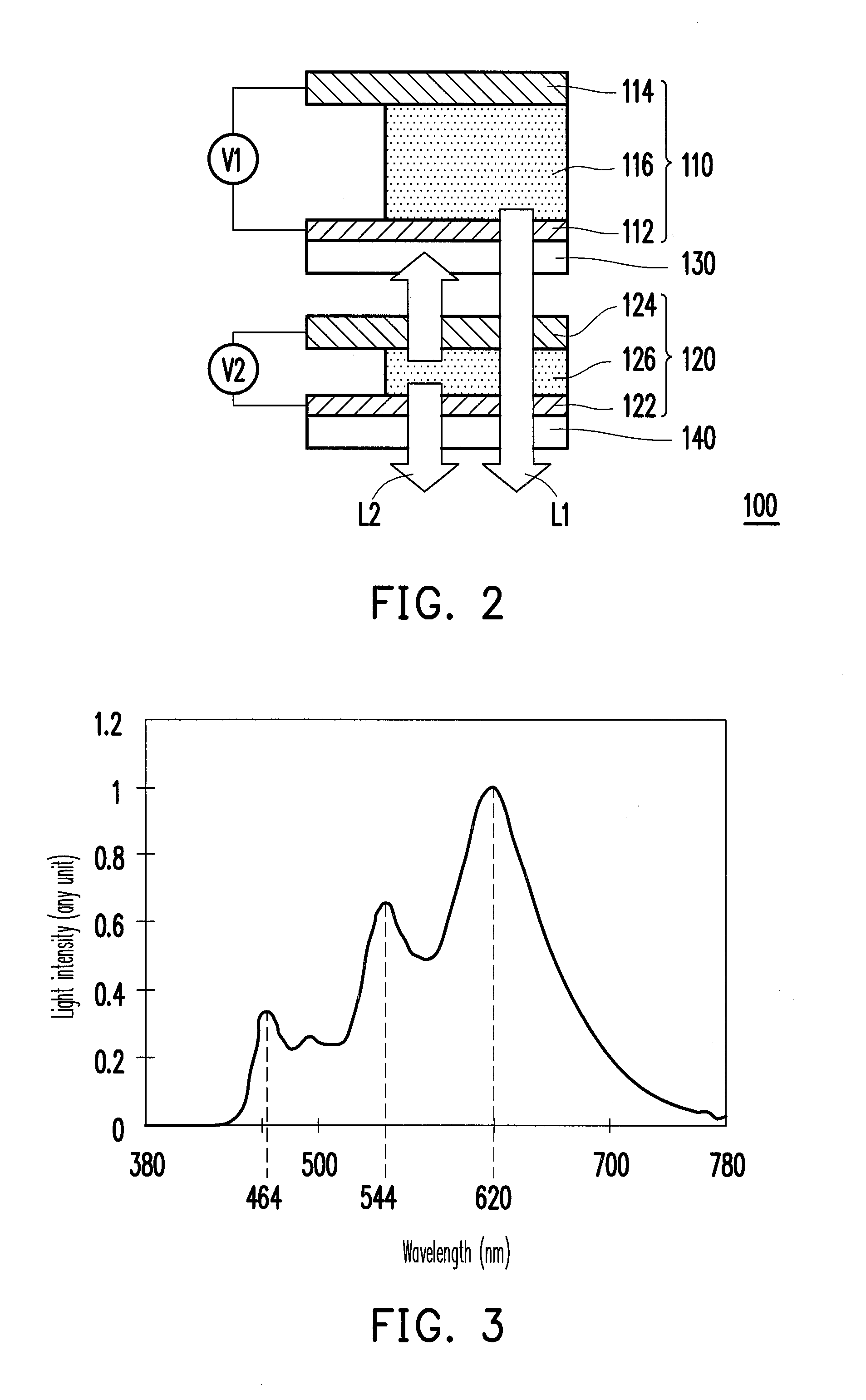Organic electroluminescent light source
a light source and organic technology, applied in the field of light sources, can solve the problems of inability to meet the color rendering index failure of the conventional organic electroluminescent lamp to meet the manufacturer's needs,
- Summary
- Abstract
- Description
- Claims
- Application Information
AI Technical Summary
Benefits of technology
Problems solved by technology
Method used
Image
Examples
first embodiment
[0018]FIG. 2 is a schematic cross-sectional diagram of the organic electroluminescent light source according to a first embodiment. Referring to FIG. 2, an organic electroluminescent light source 100 of the present embodiment includes a first organic electroluminescent device 110 and a second organic electroluminescent device 120. In the present embodiment, the first organic electroluminescent device 110 is coupled to a first bias voltage V1 to emit a first color light L1 having a color temperature ranging from 2800K to 3500K. For example, the first color light L1 emitted by the first organic electroluminescent device 110 is a white light having three intensity peaks. As depicted in FIG. 3, the three intensity peaks are 464 nanometer (nm), 544 nm, and 620 nm respectively; however, the invention is not limited thereto.
[0019]Referring to FIG. 2, the second organic electroluminescent device 120 of the present embodiment is coupled to a second bias voltage V2 to emit a second color ligh...
second embodiment
[0031]FIG. 6 is a schematic cross-sectional diagram of an organic electroluminescent light source according to a second embodiment. Referring to FIG. 6, the organic electroluminescent light source 100A of the present embodiment is similar to the organic electroluminescent light source 100 in the first embodiment. However, the two light sources have some structural differences. The structural differences are illustrated in the following and the similarities of the two are not reiterated hereinafter.
[0032]The organic electroluminescent light source 100A of the present embodiment includes a first organic electroluminescent device 110 and a second organic electroluminescent device 120. The first organic electroluminescent device 110 is coupled to a first bias voltage V1 to emit a first color light L1 having a color temperature ranging from 2800K to 3500K. The second organic electroluminescent device 120 is coupled to a second bias voltage V2 to emit a second color light L2. The first co...
third embodiment
[0034]FIG. 7 depicts a schematic cross-sectional diagram of an organic electroluminescent light source according to a third embodiment. Referring to FIG. 7, the organic electroluminescent light source 100B of the present embodiment is similar to the organic electroluminescent light source 100 in the first embodiment. However, the two light sources have some structural differences. The structural differences are illustrated in the following and the similarities of the two are not reiterated hereinafter.
[0035]The organic electroluminescent light source 100B of the present embodiment includes a first organic electroluminescent device 110 and a second organic electroluminescent device 120. The first organic electroluminescent device 110 is coupled to a first bias voltage V1 to emit a first color light L1 having a color temperature ranging from 2800K to 3500K. The second organic electroluminescent device 120 is coupled to a second bias voltage V2 to emit a second color light L2. The firs...
PUM
 Login to View More
Login to View More Abstract
Description
Claims
Application Information
 Login to View More
Login to View More - R&D
- Intellectual Property
- Life Sciences
- Materials
- Tech Scout
- Unparalleled Data Quality
- Higher Quality Content
- 60% Fewer Hallucinations
Browse by: Latest US Patents, China's latest patents, Technical Efficacy Thesaurus, Application Domain, Technology Topic, Popular Technical Reports.
© 2025 PatSnap. All rights reserved.Legal|Privacy policy|Modern Slavery Act Transparency Statement|Sitemap|About US| Contact US: help@patsnap.com



